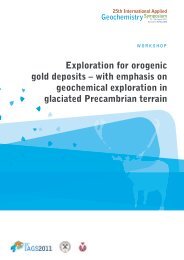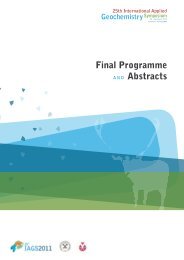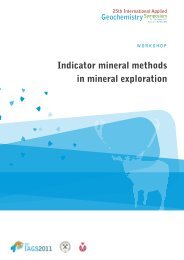Active and ongoing gold exploration and mining in ... - IAGS 2011
Active and ongoing gold exploration and mining in ... - IAGS 2011
Active and ongoing gold exploration and mining in ... - IAGS 2011
Create successful ePaper yourself
Turn your PDF publications into a flip-book with our unique Google optimized e-Paper software.
magmas (Kathol & Mart<strong>in</strong>sson 1999). The ma<strong>in</strong><br />
magmatic event can probably be set at 1.87–1.88 Ga<br />
with the emplacement of the composite monzoniticsyenitic-granitic<br />
<strong>in</strong>trusions, whereas some granites<br />
formed as late as at c. 1.86 Ga (Skiöld 1981, Skiöld<br />
& Öhl<strong>and</strong>er 1989, Mart<strong>in</strong>sson et al. 1999).<br />
Intrusions of the Perthite Monzonite Suite are<br />
suggested to be comagmatic with the Kiirunavaara<br />
Group volcanic rocks. Both display a compositional<br />
variation from mafic to felsic comb<strong>in</strong>ed with a relatively<br />
high content of alkali <strong>and</strong> HFS-elements. The<br />
<strong>in</strong>tra-plate sett<strong>in</strong>g suggested for the Kiirunavaara<br />
Group is <strong>in</strong>dicated by the chemical characteristics<br />
of the Perthite Monzonite Suite <strong>in</strong>trusions. Mantle<br />
plume orig<strong>in</strong> is supported by the abundant occurrence<br />
of mafic-ultramafic complexes northwest of<br />
Kiruna, which possibly def<strong>in</strong>e the plume centre.<br />
L<strong>in</strong>a Suite<br />
Intrusions of the L<strong>in</strong>a Suite are extensive <strong>in</strong> northern<br />
Norrbotten where they typically occur as granite,<br />
pegmatite <strong>and</strong> aplite of ma<strong>in</strong>ly m<strong>in</strong>imum melt<br />
composition generated by crustal melt<strong>in</strong>g. In F<strong>in</strong>l<strong>and</strong>,<br />
they appear to form most of the volume of the<br />
Central Lapl<strong>and</strong> Granitoid Complex (Fig. 1), <strong>and</strong><br />
are also present as smaller <strong>in</strong>trusions <strong>in</strong> many areas<br />
across northern F<strong>in</strong>l<strong>and</strong> (Lehtonen et al. 1998). However,<br />
the seismic appearance of the Central Lapl<strong>and</strong><br />
Granitoid Complex is <strong>in</strong>consistent with this area as<br />
an <strong>in</strong>trusion-rich belt, <strong>and</strong> it may have a composition<br />
comparable with the supracrustal belts to the north<br />
<strong>and</strong> south (Patison et al. 2006a). The L<strong>in</strong>a Suite is<br />
composed of monzo-, syeno-granites, <strong>and</strong> adamellite,<br />
<strong>and</strong> is characterised by its restricted SiO 2 range<br />
at 72–76 wt. %. It is peralum<strong>in</strong>ous <strong>and</strong> a high content<br />
of Rb <strong>and</strong> depletion of Eu are characteristic.<br />
The heat source generat<strong>in</strong>g the magmas<br />
might be the cont<strong>in</strong>ent-cont<strong>in</strong>ent collision events to<br />
the south <strong>and</strong> west (Öhl<strong>and</strong>er et al. 1987b, Öhl<strong>and</strong>er<br />
& Skiöld 1994, Laht<strong>in</strong>en et al. 2005) or the contemporaneous<br />
TIB 1 magmatism. Age determ<strong>in</strong>ations<br />
<strong>in</strong>dicate a relatively large span <strong>in</strong> the emplacement<br />
age at 1.81–1.78 Ga for the L<strong>in</strong>a Suite (Huhma 1986,<br />
Wikström & Persson 1997b, Perttunen & Vaasjoki<br />
2001, Rastas et al. 2001, Väänänen & Lehtonen<br />
2001, Bergman et al. 2002).<br />
A- <strong>and</strong> I-type <strong>in</strong>trusions<br />
This is the youngest of the described <strong>in</strong>trusive suites<br />
<strong>and</strong>, <strong>in</strong> the west, it forms part of the Transc<strong>and</strong><strong>in</strong>avian<br />
Igneous Belt (TIB). Two generations (c. 1.8<br />
<strong>and</strong> 1.7 Ga) of <strong>in</strong>trusions belong<strong>in</strong>g to the TIB exist<br />
<strong>in</strong> northern Sweden <strong>and</strong> adjacent areas of Norway.<br />
They commonly show quartz-poor monzonitic<br />
trends, <strong>and</strong> gabbroic-dioritic-granitic components<br />
are relatively common. (Romer et al. 1994, Öhl<strong>and</strong>er<br />
& Skiöld 1994)<br />
Across northern F<strong>in</strong>l<strong>and</strong>, the suite is represented<br />
by the Nattanen-type granitic <strong>in</strong>trusions dated<br />
at 1.80–1.77 Ga (Huhma 1986, Rastas et al. 2001).<br />
They form undeformed <strong>and</strong> unmetamorphosed, multiphase,<br />
peralum<strong>in</strong>ous, F-rich plutons which sharply<br />
cut across their country rocks. Their Nd <strong>and</strong> Hf isotopic<br />
ratios <strong>in</strong>dicate a substantial Archaean component<br />
<strong>in</strong> their source.<br />
In northern Norrbotten, monzonitic to syenitic<br />
rocks give ages between 1.80 <strong>and</strong> 1.79 (Romer<br />
et al 1994, Bergman et al. 2001), whereas granites<br />
range from 1.78–1.77 <strong>and</strong> 1.72–1.70 Ga (Romer et<br />
al. 1994). Further south, the age of the granitic Ale<br />
massif <strong>in</strong> the Luleå area is 1802±3 Ma <strong>and</strong> 1796±2<br />
Ma for the core <strong>and</strong> the rim of the massif, respectively<br />
(Öhl<strong>and</strong>er & Schöberg 1991). This is similar<br />
to the 1.80 Ga age of Edefors type monzonitic to granitic<br />
rocks (Öhl<strong>and</strong>er & Skiöld 1994).<br />
This suite can be classified as a quartz<br />
monzodiorite–quartz monzonite–adamellite–granite<br />
suite <strong>and</strong> shows a metalum<strong>in</strong>ous to peralum<strong>in</strong>ous<br />
trend with alkal<strong>in</strong>e aff<strong>in</strong>ity (Ahl et al. 2001). Lithophile<br />
elements are enriched <strong>in</strong> this suite, e.g. Zr is<br />
strongly enriched <strong>in</strong> the Edefors granitoids (Öhl<strong>and</strong>er<br />
& Skiöld 1994).<br />
Characteristic for the 1.8 Ga monzonitic to<br />
syenitic rocks is the occurrence of augite <strong>and</strong> locally<br />
also orthopyroxene <strong>and</strong> oliv<strong>in</strong>e demonstrat<strong>in</strong>g an<br />
orig<strong>in</strong> from dry magmas (Ödman 1957, Öhl<strong>and</strong>er<br />
& Skiöld 1994, Bergman et al. 2001). The Transsc<strong>and</strong><strong>in</strong>avian<br />
Igneous Belt (TIB) has been suggested<br />
to have formed <strong>in</strong> response to eastward subduction<br />
(Nyström 1982, Andersson 1991, Weihed et al.<br />
2002), possibly dur<strong>in</strong>g a period of extensional conditions<br />
(Wilson et al. 1986, Åhäll & Larsson 2000).<br />
The Edefors granitoids are <strong>in</strong>terpreted as products of<br />
plate convergence <strong>and</strong> a mantle source is suggested<br />
for these rocks based on Sm-Nd isotopic characteristics.<br />
Mafic magmas may have formed by mantle<br />
melt<strong>in</strong>g <strong>in</strong> an extensional sett<strong>in</strong>g caused by a 1.8 Ga<br />
collisional event follow<strong>in</strong>g northward subduction.<br />
These magmas were subsequently contam<strong>in</strong>ated<br />
with cont<strong>in</strong>ental crust <strong>and</strong> crystallised as monzonitic<br />
to granitic rocks (Öhl<strong>and</strong>er & Skiöld 1994).<br />
The related plate-tectonic sett<strong>in</strong>g may also<br />
be that of the f<strong>in</strong>al orogenic collapse, decompression<br />
<strong>and</strong>/or thermal resett<strong>in</strong>g <strong>in</strong> the term<strong>in</strong>al stages of the<br />
orogenic development, follow<strong>in</strong>g the cont<strong>in</strong>ent-cont<strong>in</strong>ent<br />
collisional stage (Laht<strong>in</strong>en et al. 2005).<br />
15






